
News & Updates
How is 5G working? A hair thin sensor with the answers
- Writerkrissadmin
- Date2019-07-18 00:00
- Hits12214
- 5G performance measurement system to present new standard in signal evaluation -
# On April 3rd, Korea began the world’s first 5G mobile service. However, in the early days of the service, the question on everyone’s mind seems to be “Is it working?” rather than about the key features of 5G such as ultra-high speed and hyperconnectivity. This is because the infrastructure for 5G, such as base stations, is still being built. Another reason is that there is still no accurate measurement standard for 5G performance. Thus, there is still no way to tell if the network is truly delivering 5G connectivity, even when the infrastructure is completed.
A new 5G antenna performance measurement system has been developed at the Korea Research Institute of Standards and Science. This innovative measurement system is the world’s best available technology in the field and will bring a higher standard of quality to the Korean 5G network.
A research team at the KRISS Center for Electromagnetic Metrology has developed an ultra-high speed measurement system for 5G telecommunication systems using an optical fiber based sub-millimeter scale sensor. With this technology, multiple-input and multiple-output (MIMO)* telecommunication, central to the 5G network, can now be measured with precision, down to the element level for array antennas.
? * MIMO (Multiple-Input and Multiple-Output)
The multiple-input and multiple-output (MIMO) technology is a smart antenna technology to raise the capacity of wireless telecommunications. The capacity to antennae ratio is enhanced by using many antennae in a base station or device.
The goal of 5G is hyper-connectivity, wherein all people and objects are connected. The 4G service worked as long as the telecommunications network was optimized for smartphones. However, the 5G service has to work for a wide range of services, from self-driving vehicles to IoT and artificial intelligence. Understanding the interactions between the numerous parts in the system to maintain a high quality of service has become the focus.
As quality of service is of great importance in 5G, the metric technology to determine the quality of the 5G network is an important component. However, the lack of a measurement terminal in 5G, coupled with beamforming* technology, which uses multiple antennae simultaneously, makes conditions far more complicated. Therefore, it requires a new metric technology wholly different from the existing technology.
? * Beamforming
Smart antenna technology in which beam from an antenna reaches only the targeted port. Smart antennae can be realized using multiple antennae to maximize efficiency. Multiple-input and multiple-output (MIMO) system uses multiple antennae in both transmitter and receiver.
Millimeter waves experience severe energy loss when the transmission distance increases. Beamforming is a technology that uses multiple antennae simultaneously to transmit millimeter waves while minimizing energy loss.
Although leading manufacturers around the world have proposed measurement solutions, there is currently no established worldwide standard for 5G performance measurement. Moreover, most methods proposed require costly darkroom facilities. Moreover, as the measurement sensor is larger than the 5G antenna, it is impossible to take measurements from close physical proximity, and inevitably occurring error in beamforming cannot be analyzed either.
The research team formed by Dr. Young-Pyo Hong, Dr. Dong-Joon Lee and Dr. No-Weon Kang at the KRISS Center for Electromagnetic Metrology has addressed these issues in existing technology by developing a hair-thin optical fiber-based millimeter scale sensor. The system takes up only the space of an ordinary computing unit, and can take measurements from extreme proximity, within 0.1 mm, eliminating spatial constraints.
The technology can be directly applied to the 5G industry, where infrastructure construction is currently in full swing. It will have a widespread impact as it can be used at all scales, from large base stations containing over 100 antennae, to mass produced devices that contain antennae, such as smartphones.
KRISS senior research scientist Dr. Young-Pyo Hong revealed that projects are being conducted in collaboration with various departments including networks business and mobile communication business at Samsung Electronics in regard to this technology, adding, “it will be used broadly in the evaluation of wireless communication systems to use millimeter wave frequency bands and sub-6 in the 5G era.
“This technology is the result of over 10 years of research in electromagnetic wave measurement standards, which found application in the 5G industry,” says KRISS principal research scientist Dr. No-Weon Kang, adding, “we hope it will contribute to qualitative improvements in the 5G network, taking Korean 5G from the world’s first to the world’s best.”
The source technology for the sub-millimeter scale sensor was published in the leading journals Optics Letters (IF: 3.589) and Sensors (IF: 3.031) in June. It is currently in the process of full-scale commercialization through technology transfer.
○ Explanation of 5G performance measurement system
The key to this technology is the sub-millimeter scale optic crystal, which measures 0.2 mm wide, 0.2 mm long and 0.05 mm thick (the sensor part of the probe), attached to the end of a very thin optical fiber to create a probe as fine as a human hair (the average thickness of human hair is approximately 0.08 mm.)
The team also developed an optical measurement system in a single computing unit the size of a desktop computer. Using this system, measurements and analyses can be conducted in extreme proximity, within 0.1 mm of the antenna, without spatial constraints.
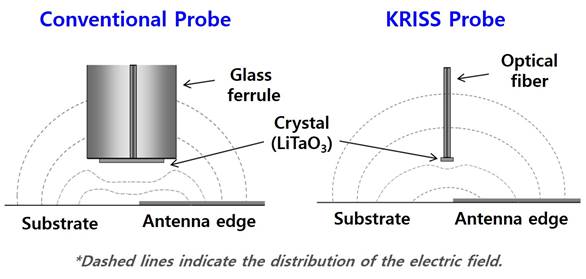
▲ Measurement methods used by the conventional probe (left) and the sub-millimeter scale probe (right) developed at KRISS
- As conventional probes using metallic sensors are larger in size (several centimeters long), they produce distortion in the antenna performance during measurement. Thus, measurements have to be taken at a distance (several tens of centimeters) that depends on the distortion level.
- As the sensor developed by KRISS is very small (hair-thin) and made of dielectric material, it produces almost no distortion of antenna performance during measurement. It can also take precise measurements from very close range (within 0.1 mm).
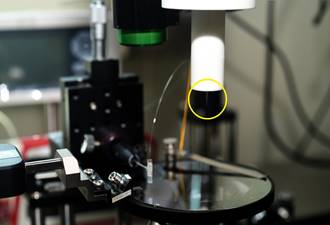
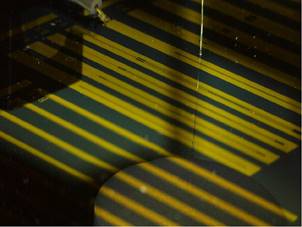
▲ Optical fiber based sub-millimeter sensor
(Left) The very fine sensor can be seen in the yellow circle in the photo.
(Right) Taking measurements from a very fine microstrip (with 6 micrometer-thick lines) using the sensor.
○ What are its applications?
1. 5G mobile telecom industry- evaluating performance of mobile networks and base stations
KRISS’s unique measurement system, which sets itself apart from conventional chamber (darkroom) based measurement systems, can be used to evaluate and verify the quality of sub-6 GHz and millimeter wave 5G mobile telecom systems. It will start a new paradigm in 5G measurement solutions based on an ultra-high speed and high quality measurement platform.
2. Semiconductor processing- detecting faults in transmission lines
As the system is contactless, it can be used to identify and locate with high precision strip thickness variations and circuit breaks (or short circuits) caused by process errors in micrometer (1/1,000,000 meter) scale high density transmission lines. It can be used as a fault detection system for developing and enhancing the quality of semiconductor process-based electronics.
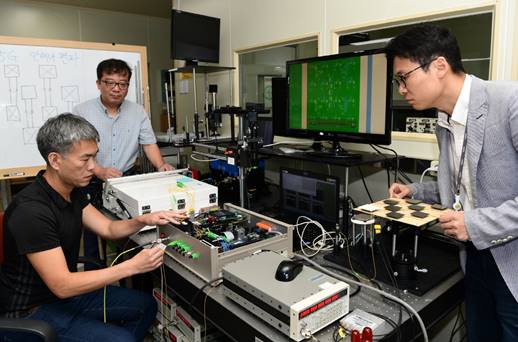
▲ Research team at KRISS Center for Electromagnetic Metrology (From left, Dr. Dong-Joon Lee, Dr. No-Weon Kang, and Dr. Young-Pyo Hong) is measuring properties of antennae used in commercial 5G base stations.
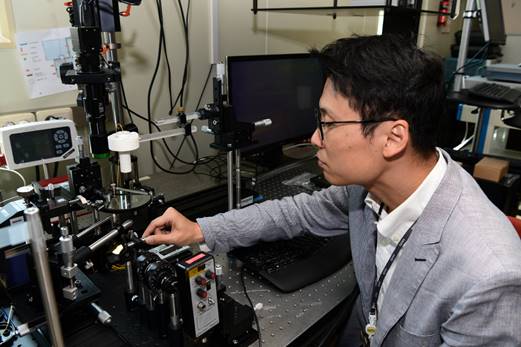
▲ Dr. Young-Pyo Hong is evaluating a semiconductor process based microstrip using the sub-millimeter scale sensor.
QUICK MENU 원하시는 서비스를 클릭하세요!
등록된 퀵메뉴가 없습니다.
